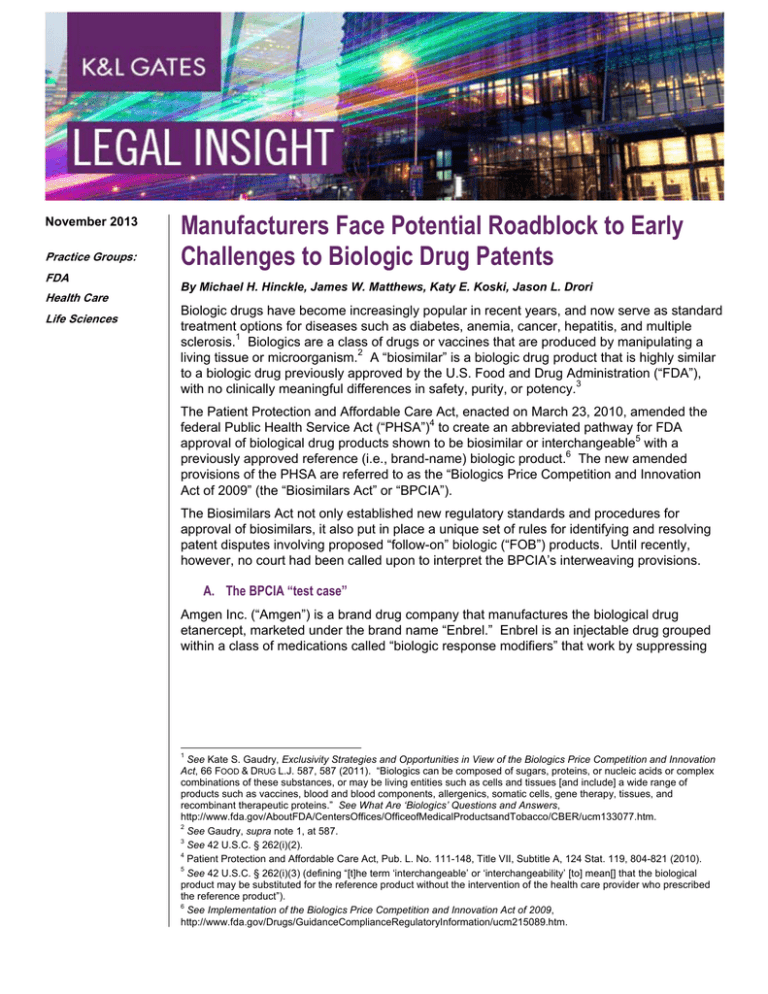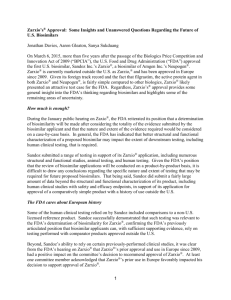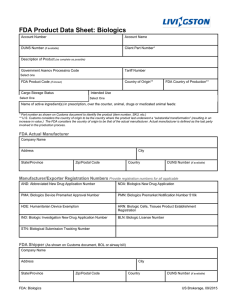
November 2013
Practice Groups:
FDA
Manufacturers Face Potential Roadblock to Early
Challenges to Biologic Drug Patents
By Michael H. Hinckle, James W. Matthews, Katy E. Koski, Jason L. Drori
Health Care
Life Sciences
Biologic drugs have become increasingly popular in recent years, and now serve as standard
treatment options for diseases such as diabetes, anemia, cancer, hepatitis, and multiple
sclerosis.1 Biologics are a class of drugs or vaccines that are produced by manipulating a
living tissue or microorganism.2 A “biosimilar” is a biologic drug product that is highly similar
to a biologic drug previously approved by the U.S. Food and Drug Administration (“FDA”),
with no clinically meaningful differences in safety, purity, or potency.3
The Patient Protection and Affordable Care Act, enacted on March 23, 2010, amended the
federal Public Health Service Act (“PHSA”)4 to create an abbreviated pathway for FDA
approval of biological drug products shown to be biosimilar or interchangeable5 with a
previously approved reference (i.e., brand-name) biologic product.6 The new amended
provisions of the PHSA are referred to as the “Biologics Price Competition and Innovation
Act of 2009” (the “Biosimilars Act” or “BPCIA”).
The Biosimilars Act not only established new regulatory standards and procedures for
approval of biosimilars, it also put in place a unique set of rules for identifying and resolving
patent disputes involving proposed “follow-on” biologic (“FOB”) products. Until recently,
however, no court had been called upon to interpret the BPCIA’s interweaving provisions.
A. The BPCIA “test case”
Amgen Inc. (“Amgen”) is a brand drug company that manufactures the biological drug
etanercept, marketed under the brand name “Enbrel.” Enbrel is an injectable drug grouped
within a class of medications called “biologic response modifiers” that work by suppressing
1
See Kate S. Gaudry, Exclusivity Strategies and Opportunities in View of the Biologics Price Competition and Innovation
Act, 66 FOOD & DRUG L.J. 587, 587 (2011). “Biologics can be composed of sugars, proteins, or nucleic acids or complex
combinations of these substances, or may be living entities such as cells and tissues [and include] a wide range of
products such as vaccines, blood and blood components, allergenics, somatic cells, gene therapy, tissues, and
recombinant therapeutic proteins.” See What Are ‘Biologics’ Questions and Answers,
http://www.fda.gov/AboutFDA/CentersOffices/OfficeofMedicalProductsandTobacco/CBER/ucm133077.htm.
2
See Gaudry, supra note 1, at 587.
3
See 42 U.S.C. § 262(i)(2).
4
Patient Protection and Affordable Care Act, Pub. L. No. 111-148, Title VII, Subtitle A, 124 Stat. 119, 804-821 (2010).
5
See 42 U.S.C. § 262(i)(3) (defining “[t]he term ‘interchangeable’ or ‘interchangeability’ [to] mean[] that the biological
product may be substituted for the reference product without the intervention of the health care provider who prescribed
the reference product”).
6
See Implementation of the Biologics Price Competition and Innovation Act of 2009,
http://www.fda.gov/Drugs/GuidanceComplianceRegulatoryInformation/ucm215089.htm.
Manufacturers Face Potential Roadblock to Early
Challenges to Biologic Drug Patents
the immune system to block proteins that contribute to the disease process.7 The FDA first
approved Enbrel in 1998 for the treatment of moderate to severe rheumatoid arthritis.8
On June 24, 2013, generic drug manufacturer Sandoz Inc. (“Sandoz”) filed a declaratory
judgment action in the United States District Court for the Northern District of California
seeking a declaration of patent noninfringement and invalidity against Amgen and Swiss
drug maker Hoffman-La Roche Inc. (“Roche”), which owns two patents related to Enbrel that
were exclusively licensed to Amgen.9 Sandoz sought a declaration that the biosimilar
etanercept product it had been developing and taken steps to commercialize since 2004
would not infringe any valid claim of the two Roche patents covering Enbrel—all in
anticipation of filing an application with the FDA for regulatory approval.10
Amgen and Roche moved to dismiss the complaint on jurisdictional grounds.11 They argued
first that the court lacked subject matter jurisdiction because “neither Roche nor Amgen have
ever threatened Plaintiff or otherwise done anything to create a dispute of sufficient
immediacy and reality to warrant a declaratory judgment action”; in particular, they argued
against “declaratory judgment jurisdiction for a therapeutic where no FDA application ha[d]
been filed and the requisite clinical trials ha[d] not yet been completed.”12 They asked that
the court decline declaratory judgment jurisdiction because, practically speaking,
“[a]djudication of the validity and infringement of the Roche patents would be unlikely to
finally and conclusively resolve all underlying controversies that might be created by
Sandoz’s importation, use, offer for sale or sale of an etanercept product upon FDA approval
. . . .”13
Sandoz responded that “specific threats of infringement are not required” to confer
jurisdiction but only a real and immediate conflict, which it claimed existed after “Amgen ha[d]
trumpeted its ‘exclusivity’ under its new patents to the entire industry, time and again, and
made clear its strategy for Enbrel depends on excluding all competition”—something Sandoz
contended “leaves no doubt of [Amgen’s] intent to enforce the ’182 and ’522 patents against
Sandoz.”14 Sandoz urged that “a declaratory judgment action [was] necessary to achieve
patent certainty prior to Sandoz’s commercial marketing,” without which, Sandoz argued, “it
will be required to shelve its product or risk the potential for significant liability by launching
it.”15
7
See What is ENBREL?, http://www.enbrel.com/what-is-ENBREL.jspx.
See Etanercept Product Approval Information—Licensing Action 12/2/98,
http://www.fda.gov/Drugs/DevelopmentApprovalProcess/HowDrugsareDevelopedandApproved/ApprovalApplications/Ther
apeuticBiologicApplications/ucm080536.htm.
9
See Complaint for Declaratory Judgment of Patent Invalidity and Non-Infringement (“Complaint”) at ¶ 1-5, 11, Sandoz
Inc. v. Amgen Inc. et al., 2013 WL 6000069 (N.D. Cal. Nov. 12, 2013) (No.: 3:13-cv-02904-NC); see also Enbrel®
(etanercept) Patent Issued, AMGEN.COM (NOV. 22 2011),
http://www.amgen.com/media/media_pr_detail.jsp?releaseID=1633115.
10
See Complaint at ¶¶ 3, 72.
11
See Motion by Defendants, Amgen, Inc. and Hoffmann-La Roche, Inc. to Dismiss for Lack of Subject-Matter Jurisdiction
or, Alternatively, to Decline to Exercise Declaratory Judgment Jurisdiction, Sandoz Inc. v. Amgen Inc. et al., 2013 WL
6000069 (N.D. Cal. Nov. 12, 2013) (No.: 3:13-cv-02904-NC).
12
See id. at 19, 21.
13
See id. at 22.
14
See Sandoz Inc.’s Opposition to Defendants’ Motion to Dismiss at 2, 15, Sandoz Inc. v. Amgen Inc. et al., 2013 WL
6000069 (N.D. Cal. Nov. 12, 2013) (No.: 3:13-cv-02904-NC).
15
See id. at 1, 23. On the contrary, Sandoz asserted that “the BPCIA provides DJ actions can be filed by either party
upon the biosimilar manufacturer’s notice of commercial marketing, which Sandoz has given here.” See id. at 24.
8
2
Manufacturers Face Potential Roadblock to Early
Challenges to Biologic Drug Patents
On November 12, 2013, the California federal district court sided with Amgen and Roche and
granted their motion to dismiss without prejudice, finding first that “Sandoz does not contend,
and cannot contend, it has complied with its obligations under [the BPCIA] because . . . it has
not, to date, filed an application with the FDA.”16 The BPCIA provides, in relevant part, that
“[t]he subsection (k) applicant [i.e., the FOB maker] shall provide notice to the reference
product sponsor not later than 180 days before the date of the first commercial marketing of
the biological product licensed under subsection (k).”17 Then, “[i]f a subsection (k) applicant
provides the application and information required under paragraph (2)(A), neither the
reference product sponsor nor the subsection (k) applicant may, prior to the date notice is
received . . . bring any action . . . for a declaration of infringement, validity, or enforceability of
any patent . . . .”18 Here, the court reasoned, “Sandoz cannot, as a matter of law, have
provided a notice of commercial marketing because . . . its etanercept product [was] not
licensed under subsection (k).”19
The court further held that “Sandoz ha[d] not, at this time, established a real and immediate
injury or threat of future injury that is caused by the defendants.”20 Specifically, it “submitted
[no] evidence demonstrating defendants, by some means other than an express threat to
sue, have subjected Sandoz to an ‘immediate’ threat of injury”; instead, the “public
statements by Amgen that its patents cover etanercept, and that it defends the patents it
owns . . . do not suffice to show an ‘imminent threat’ . . . .”21 Finally, and perhaps most
importantly, the court ruled that “Sandoz’s allegation that it intends in the future to file an
application with the FDA is insufficient to create a case or controversy” for purposes of
establishing federal subject matter jurisdiction.22
B. What does it mean?
The November ruling, the first to interpret the litigation provisions of the Biosimilars Act, has
no doubt created waves for manufacturers of biosimilars and may set a precedent with farreaching implications. First among these is a requirement that a manufacturer of biosimilars
must seek FDA approval for its version of a biologic drug before filing legal challenges to the
patents on previously approved biologics. From a procedural standpoint, the court’s decision
means (for the time being) that the “notice of commercial marketing” needed to trigger the
right to file a declaratory action cannot attach to an unlicensed FOB, putting “patent certainty”
further from reach.
The conclusions by the Northern District of California appear faithful to the provisions of the
BPCIA but at the same time seem to be at odds with the law’s intended purpose of
expediting approval of FOBs to foster increased competition among biologics manufacturers,
with the ultimate goal being lower prices for these products. Whether other federal courts in
California or elsewhere will similarly construe the BPCIA’s complex rules remains to be seen
and is worth closely watching. Also interesting will be whether pushback against the law
16
See Sandoz Inc. v. Amgen Inc. et al., No.: 3:13-cv-02904-NC, 2013 WL 6000069, at *2 (N.D. Cal. Nov. 12, 2013)
(internal quotations omitted).
17
See 42 U.S.C. § 262(l)(8)(A).
18
See 42 U.S.C. § 262(l)(9)(A).
19
See Sandoz Inc., at *2 (internal quotations omitted).
20
See id. (internal quotations omitted).
21
See id.
22
See id. at *3.
3
Manufacturers Face Potential Roadblock to Early
Challenges to Biologic Drug Patents
from health care industry participants of different stripes will prompt the FDA to issue
clarifying regulations to simplify the BPCIA’s implementation.
Authors:
Michael H. Hinckle
James W. Matthews
michael.hinckle@klgates.com
+1.919.466.1115
james.matthews@klgates.com
+1.617.261.3197
Katy E. Koski
Jason L. Drori
katy.koski@klgates.com
+1.617.261.3194
jason.drori@klgates.com
+1.617.951.9143
Anchorage Austin Beijing Berlin Boston Brisbane Brussels Charleston Charlotte Chicago Dallas Doha Dubai Fort Worth Frankfurt
Harrisburg Hong Kong Houston London Los Angeles Melbourne Miami Milan Moscow Newark New York Orange County Palo Alto Paris
Perth Pittsburgh Portland Raleigh Research Triangle Park San Diego San Francisco São Paulo Seattle Seoul Shanghai Singapore Spokane
Sydney Taipei Tokyo Warsaw Washington, D.C. Wilmington
K&L Gates practices out of 48 fully integrated offices located in the United States, Asia, Australia, Europe, the Middle East and South
America and represents leading global corporations, growth and middle-market companies, capital markets participants and
entrepreneurs in every major industry group as well as public sector entities, educational institutions, philanthropic organizations and
individuals. For more information about K&L Gates or its locations, practices and registrations, visit www.klgates.com.
This publication is for informational purposes and does not contain or convey legal advice. The information herein should not be used or relied upon in
regard to any particular facts or circumstances without first consulting a lawyer.
©2013 K&L Gates LLP. All Rights Reserved.
4






